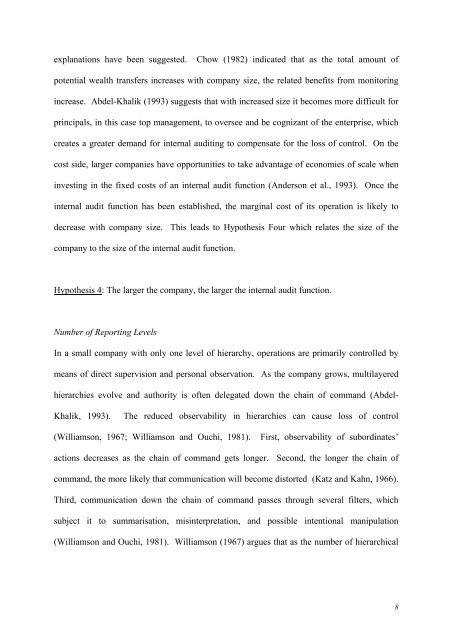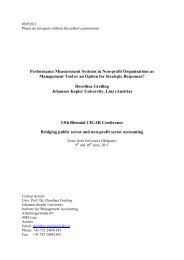WORKING PAPER - Faculteit Economie en Bedrijfskunde
WORKING PAPER - Faculteit Economie en Bedrijfskunde
WORKING PAPER - Faculteit Economie en Bedrijfskunde
Create successful ePaper yourself
Turn your PDF publications into a flip-book with our unique Google optimized e-Paper software.
explanations have be<strong>en</strong> suggested. Chow (1982) indicated that as the total amount of<br />
pot<strong>en</strong>tial wealth transfers increases with company size, the related b<strong>en</strong>efits from monitoring<br />
increase. Abdel-Khalik (1993) suggests that with increased size it becomes more difficult for<br />
principals, in this case top managem<strong>en</strong>t, to oversee and be cognizant of the <strong>en</strong>terprise, which<br />
creates a greater demand for internal auditing to comp<strong>en</strong>sate for the loss of control. On the<br />
cost side, larger companies have opportunities to take advantage of economies of scale wh<strong>en</strong><br />
investing in the fixed costs of an internal audit function (Anderson et al., 1993). Once the<br />
internal audit function has be<strong>en</strong> established, the marginal cost of its operation is likely to<br />
decrease with company size. This leads to Hypothesis Four which relates the size of the<br />
company to the size of the internal audit function.<br />
Hypothesis 4: The larger the company, the larger the internal audit function.<br />
Number of Reporting Levels<br />
In a small company with only one level of hierarchy, operations are primarily controlled by<br />
means of direct supervision and personal observation. As the company grows, multilayered<br />
hierarchies evolve and authority is oft<strong>en</strong> delegated down the chain of command (Abdel-<br />
Khalik, 1993). The reduced observability in hierarchies can cause loss of control<br />
(Williamson, 1967; Williamson and Ouchi, 1981). First, observability of subordinates’<br />
actions decreases as the chain of command gets longer. Second, the longer the chain of<br />
command, the more likely that communication will become distorted (Katz and Kahn, 1966).<br />
Third, communication down the chain of command passes through several filters, which<br />
subject it to summarisation, misinterpretation, and possible int<strong>en</strong>tional manipulation<br />
(Williamson and Ouchi, 1981). Williamson (1967) argues that as the number of hierarchical<br />
8
















